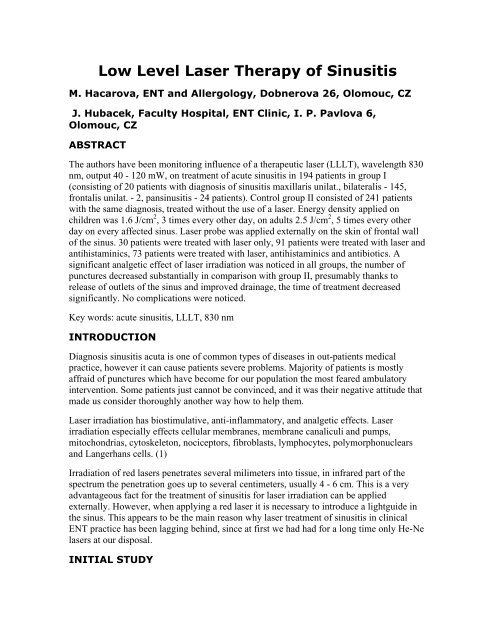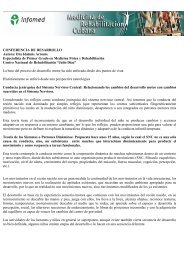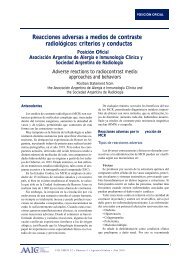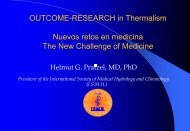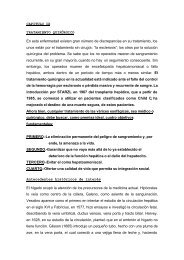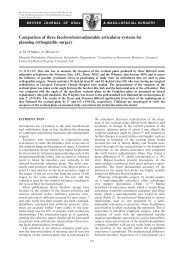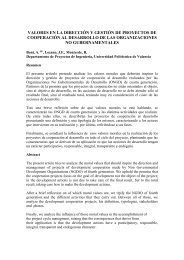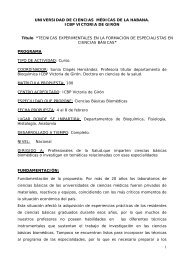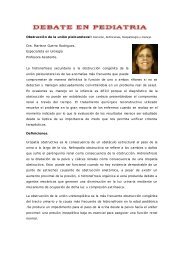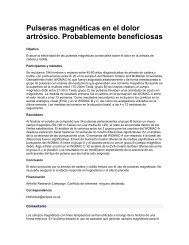Low Level Laser Therapy of Sinusitis
Low Level Laser Therapy of Sinusitis
Low Level Laser Therapy of Sinusitis
You also want an ePaper? Increase the reach of your titles
YUMPU automatically turns print PDFs into web optimized ePapers that Google loves.
<strong>Low</strong> <strong>Level</strong> <strong>Laser</strong> <strong>Therapy</strong> <strong>of</strong> <strong>Sinusitis</strong><br />
M. Hacarova, ENT and Allergology, Dobnerova 26, Olomouc, CZ<br />
J. Hubacek, Faculty Hospital, ENT Clinic, I. P. Pavlova 6,<br />
Olomouc, CZ<br />
ABSTRACT<br />
The authors have been monitoring influence <strong>of</strong> a therapeutic laser (LLLT), wavelength 830<br />
nm, output 40 - 120 mW, on treatment <strong>of</strong> acute sinusitis in 194 patients in group I<br />
(consisting <strong>of</strong> 20 patients with diagnosis <strong>of</strong> sinusitis maxillaris unilat., bilateralis - 145,<br />
frontalis unilat. - 2, pansinusitis - 24 patients). Control group II consisted <strong>of</strong> 241 patients<br />
with the same diagnosis, treated without the use <strong>of</strong> a laser. Energy density applied on<br />
children was 1.6 J/cm 2 , 3 times every other day, on adults 2.5 J/cm 2 , 5 times every other<br />
day on every affected sinus. <strong>Laser</strong> probe was applied externally on the skin <strong>of</strong> frontal wall<br />
<strong>of</strong> the sinus. 30 patients were treated with laser only, 91 patients were treated with laser and<br />
antihistaminics, 73 patients were treated with laser, antihistaminics and antibiotics. A<br />
significant analgetic effect <strong>of</strong> laser irradiation was noticed in all groups, the number <strong>of</strong><br />
punctures decreased substantially in comparison with group II, presumably thanks to<br />
release <strong>of</strong> outlets <strong>of</strong> the sinus and improved drainage, the time <strong>of</strong> treatment decreased<br />
significantly. No complications were noticed.<br />
Key words: acute sinusitis, LLLT, 830 nm<br />
INTRODUCTION<br />
Diagnosis sinusitis acuta is one <strong>of</strong> common types <strong>of</strong> diseases in out-patients medical<br />
practice, however it can cause patients severe problems. Majority <strong>of</strong> patients is mostly<br />
affraid <strong>of</strong> punctures which have become for our population the most feared ambulatory<br />
intervention. Some patients just cannot be convinced, and it was their negative attitude that<br />
made us consider thoroughly another way how to help them.<br />
<strong>Laser</strong> irradiation has biostimulative, anti-inflammatory, and analgetic effects. <strong>Laser</strong><br />
irradiation especially effects cellular membranes, membrane canaliculi and pumps,<br />
mitochondrias, cytoskeleton, nociceptors, fibroblasts, lymphocytes, polymorphonuclears<br />
and Langerhans cells. (1)<br />
Irradiation <strong>of</strong> red lasers penetrates several milimeters into tissue, in infrared part <strong>of</strong> the<br />
spectrum the penetration goes up to several centimeters, usually 4 - 6 cm. This is a very<br />
advantageous fact for the treatment <strong>of</strong> sinusitis for laser irradiation can be applied<br />
externally. However, when applying a red laser it is necessary to introduce a lightguide in<br />
the sinus. This appears to be the main reason why laser treatment <strong>of</strong> sinusitis in clinical<br />
ENT practice has been lagging behind, since at first we had had for a long time only He-Ne<br />
lasers at our disposal.<br />
INITIAL STUDY
We have iniciated laser treatment <strong>of</strong> sinusitis with a therapeutic diode laser with<br />
wavelength 830 nm, the beam <strong>of</strong> which penetrates more than 4 cm into tissue. With 40 and<br />
80 mW output power we used continuous mode as well as pulsed frequency 9.12 Hz.<br />
Picture 1a: <strong>Sinusitis</strong> maxillaris - points <strong>of</strong><br />
irradiation<br />
Picture 1b: <strong>Sinusitis</strong> frontalis - points <strong>of</strong><br />
irradiation<br />
We irradiated the whole area above the sinuses, children three times with energy density<br />
1.6 J/cm 2 every other day on each sinus, adults five times with energy density 2.5 J/cm 2<br />
every other day on each sinus.<br />
Group I consisted <strong>of</strong> 223 patients with diagnosis <strong>of</strong> sinusitis acuta with manifestations on<br />
maxillar sinuses, frontal sinuses and with pansinusitis.<br />
We rejected 29 patients due for their clear evaluation was not possible due to the following<br />
reasons: condition after a surgery on sinuses, relapsing sinusitis on a rugged chronic<br />
operation field, or polyposis. With these patients x-ray pictures after the therapy could only<br />
hardly be evaluated.<br />
Furthermore, other patients with immune system disorders and patients on whom LLLT<br />
had not been applied since the beginning <strong>of</strong> the treatment were rejected. Finally, one patient<br />
was rejected due to absence on his check up visit, too.<br />
For comparative evaluation a retrospective monitoring <strong>of</strong> group II was used, where no laser<br />
was applied. Group II consisted <strong>of</strong> 241 patients, followed in our <strong>of</strong>fice between January 1<br />
and December 31, 1997. Criteria for putting on group II was identical with those <strong>of</strong> group I,<br />
our surgery was not equipped with a laser at that time. The parameters followed in groups I<br />
and II (data in brackets) are presented in Table 1.<br />
Table 1: Affection <strong>of</strong> individual sines<br />
Affection <strong>of</strong> sinuses unilateral bilateral
<strong>Sinusitis</strong> maxillaris 20 (97) 145 (108)<br />
<strong>Sinusitis</strong> frontalis 3 (3) 2 (2)<br />
Pansinusitis 24 (31)<br />
In total 194 patients were evaluated in group I (69 children, 91 women, 34 men) with the<br />
age ranging from 4 to 70 years (Diagram 1), average age <strong>of</strong> adults was 43 years.<br />
In group II 241 patients were evaluated (71 children, 112 women, 58 men), age ranging<br />
from 5 to 83 years (see Diagram 1), average age 38,5 years.<br />
Diagram 1: Composition <strong>of</strong> groups I and II<br />
<strong>Therapy</strong> was chosen in correspondence with the health condition <strong>of</strong> a patient and with<br />
regard to his/her clinical diagnosis, verified by a conventional x-ray picture <strong>of</strong> the sinuses.<br />
All our patients had taken standard nasal anaemic drops even before determination <strong>of</strong> the<br />
diagnosis sinusitis acuta.<br />
On patients gathered in set A we applied laser (LLLT) only. Set B was treatred with laser +<br />
antihistaminics (loratadine or cetirizine), set C with laser + antihistaminics + antibiotics<br />
(usually amoxilines only, or enriched with potassium clavulanate or cefalosporines, in the<br />
event <strong>of</strong> preceding adverse reaction to ATB we used quite extraordinarily macrolides or<br />
clindamycine) in accordance with experience <strong>of</strong> ENT specialists <strong>of</strong> University <strong>of</strong> Irvine,<br />
California (7). (See Table 2).<br />
Table 2: Group I<br />
<strong>Sinusitis</strong> acuta<br />
Set A - laser<br />
Set C - laser +<br />
Set B - laser +<br />
antihistaminics<br />
antihistaminics<br />
+ ATB<br />
Total<br />
Patients<br />
with<br />
punctures
Catarrhal 26 56 21 103 1<br />
Catarrhal + hyperplasia 3 14 17 34 0<br />
Homogeneous veil 0 16 23 39 9<br />
Liquid level 1 5 12 18 1<br />
Total 30 91 73 194 11<br />
In group II set A (laser) was excluded, other groups received the same medication as in<br />
group I. (See Table 3)<br />
Table 3: Group II<br />
<strong>Sinusitis</strong> acuta<br />
Set A - laser<br />
Set C - laser +<br />
Set B - laser +<br />
antihistaminics<br />
antihistaminics<br />
+ ATB<br />
Patients<br />
Total with<br />
punctures<br />
Catarrhal 0 44 52 96 11<br />
Catarrhal + hyperplasia 0 17 40 57 18<br />
Homogeneous veil 0 9 42 51 23<br />
Liquid level 0 6 31 37 21<br />
Total 0 76 165 241 73<br />
Average length <strong>of</strong> treatment was set from determination <strong>of</strong> diagnosis till clinical<br />
physiological ENT finding. Three patients from monitored group suffered from sinusitis<br />
maxillaris acuta twice in one year with 6 months interval, the group was monitored from<br />
December 1, 1998, till July 1, 2000, i.e. one and a half year in total.<br />
Table 4: Average length <strong>of</strong> treatment in days - group I<br />
<strong>Sinusitis</strong> acuta<br />
Set A - laser<br />
Set B - laser +<br />
antihistaminics<br />
Set C - laser +<br />
antihistaminics +<br />
ATB<br />
Catarrhal 6.3 7.9 7.6<br />
Catarrhal +<br />
hyperplasia<br />
9.5 8.5 9<br />
Homogeneous veil 0 10.5 9.5<br />
Liquid level 8 7.8 9.4<br />
All patients were always monitored in the first day <strong>of</strong> treatment (once in the course <strong>of</strong><br />
therapy) and upon the day <strong>of</strong> termination <strong>of</strong> therapy, all patients presented themselves for<br />
an ENT check up 6 months after the termination <strong>of</strong> therapy. Upon termination <strong>of</strong> treatment<br />
control x-rays <strong>of</strong> sinuses <strong>of</strong> patients with homogeneous veil or <strong>of</strong> patients with the findings
<strong>of</strong> liquid levels were taken, whilst control x-rays <strong>of</strong> patients with minor forms <strong>of</strong> sinusitis<br />
were taken only exceptionally. Average length <strong>of</strong> treatment in group II without LLLT<br />
application varied from 11.1 to 18.8 days.<br />
Table 5: Average length <strong>of</strong> treatment in days - group II<br />
<strong>Sinusitis</strong> acuta<br />
Set A - laser<br />
Set B - laser +<br />
antihistaminics<br />
Set C - laser +<br />
antihistaminics +<br />
ATB<br />
Catarrhal 0 11.1 12.4<br />
Catarrhal +<br />
hyperplasia<br />
0 12,3 13.6<br />
Homogeneous veil 0 14.2 11.4<br />
Liquid level 0 18.8 17.5<br />
DISCUSSION<br />
Only few papers on laser treatment <strong>of</strong> sinusitis can be found in literature. Kruchinina et al.<br />
(2) irradiated catarrhal and purulent maxillar sinusitis, both acute and chronic in 120<br />
children inpatients in the age <strong>of</strong> 6 to 15 years, with He-Ne laser. A lightguide was inserted<br />
in the cavity by a drain, laser output power was 7mW/cm 2 , irradiation time 3 - 6 minutes<br />
daily. Consolidation came after 5 - 9 applications. Prior to therapy immunological<br />
examination showed decreased sIgA in the secret <strong>of</strong> the cavity, however values increased<br />
significantly after the treatment.<br />
Plouzhnikov et al. (3) consider LLLT <strong>of</strong> acute and chronic sinusitis an important part <strong>of</strong> a<br />
comprehensive medicine. They irradiate with He-Ne laser 10mW/cm 2 by a lightguide<br />
inserted in the sinus through a puncture needle, 2 - 3 times on acute, and 5 - 9 times on<br />
chronic sinusitis. Energy density 2.1 - 8.4 J/cm 2 has anti-inflammatory, anti-oedematous<br />
and analgesic effects.<br />
Prazak (4) uses a semicinductor laser 830 nm. In case <strong>of</strong> an acute frontal sinusitis he applies<br />
3 J/cm 2 on the area <strong>of</strong> foramen supraorbitale, and on another two frontal points <strong>of</strong><br />
metopantron 1.5 J/cm 2 on each. In case <strong>of</strong> inflammation <strong>of</strong> gnathic sinus he irradiates the<br />
area <strong>of</strong> foramen infraorbitale by 3 J/cm 2 , and the areas <strong>of</strong> fossa canina a processus<br />
zygomaticus by 2 J/cm 2 . Simultaneously, he administers antipyretics, or antibiotics per os.<br />
LLLT decreases subjective complaints, especially headaches. He irradiates every day till<br />
consolidation, on chronic sinusitis 8 - 10 applications every other day.<br />
Moustsen (5) with a group <strong>of</strong> colleagues from Aarhus Universitet conducted a double blind<br />
randomized study in 60 patients, on whom they applied laser irradiation <strong>of</strong> 30 mW, 830<br />
nm, for 90 seconds, in three sessions on each sinus in 1 - 3 days interval. They found no<br />
statistically important difference between laser and placebo as far as pain feeling, disease<br />
duration, nor overall condition are concerned.
Simunovic (6) presents in the chapter "LLLT in ENT" treatment <strong>of</strong> sinusitis with a diode IR<br />
laser. He recommended energy density 2 - 4 J/cm 2 on mucous inflammations. Compared to<br />
other specialties, the chapter devoted to ENT is unusually brief - 3 pages <strong>of</strong> text only.<br />
<strong>Therapy</strong> <strong>of</strong> sinusitis is focussed on suppressing infection, influencing unpleasant symptoms<br />
- especially pain, shortening duration <strong>of</strong> disease, preventing relapses and transformation<br />
into chronic phasis <strong>of</strong> the disease. These were our main concerns when monitoring the<br />
influence <strong>of</strong> laser irradiation on sinusitis.<br />
1. We can quite unambiguously confirm a positive effect <strong>of</strong> laser on diminishing pain. In<br />
all monitored sets a relief <strong>of</strong> pressure and pain was noticed within 24 hours after the first<br />
irradiation in group I.<br />
2. In therapy <strong>of</strong> sinusitis it is important to attain re-ventilation <strong>of</strong> the cavity and functional<br />
mucocilliar transportation <strong>of</strong> the secretion, depending on interaction <strong>of</strong> the mucus and<br />
function <strong>of</strong> cilia.<br />
Significant decrease <strong>of</strong> number <strong>of</strong> patients, who had to undergo a puncture, bears witness to<br />
an influence <strong>of</strong> laser irradiation on release <strong>of</strong> outlets <strong>of</strong> sines and restoration <strong>of</strong> mucocilliar<br />
transportation. In gnathic and metopic sines the transportation is circular and it is directed<br />
by determined drainage paths, leading to natural sinusal outlets. The transportation ceases<br />
due to various reasons - toxins, medicaments, temperature, relation between liquid and<br />
viscose layers <strong>of</strong> the mucus, surfactants,or bilateral contact <strong>of</strong> the surface <strong>of</strong> the mucose,<br />
especially in the area <strong>of</strong> the outlets.<br />
Most punctures, 8 <strong>of</strong> total 11 monitored patients with punctures in our group I, were<br />
performed in the cathegory with homogenous obscure <strong>of</strong> the sines treated with laser and<br />
antihistaminics (set B), whilst only one <strong>of</strong> 29 patients in the cathegory with homogenous<br />
obscure <strong>of</strong> the sinuses had to undergo punctures when treated with laser + antihistaminics +<br />
antibiotics (set C). Puncture empyema in set B was both blennoid and purulent. The<br />
number <strong>of</strong> patients with punctures in group II was also highest in the group with<br />
homogenous obscure - 23 patients (neither number <strong>of</strong> punctures, nor laterality was not<br />
taken into account). <strong>Laser</strong> irradiation is expected to bring a positive influence due to its<br />
anti-inflammatory and anti-oedematic effects especially in the area <strong>of</strong> the outlets. In the<br />
case <strong>of</strong> a homogenous obscure quantity, composition, and pressure <strong>of</strong> the mucus<br />
substantially impairs mucociliar transportation and, furthermore, the mucus prevents<br />
penetration <strong>of</strong> laser irradiation. Addition <strong>of</strong> antibiotics may contribute to a quicker<br />
elimination <strong>of</strong> inflammation.<br />
3. Acute rhinogenous sinusitis is usually primarily viral, with secondary bacterial<br />
superinfection. According to our experience (8) laser irradiation has no bactericidal effect,<br />
however it causes reduction <strong>of</strong> cytopatogenous effect <strong>of</strong> herpes simplex virus, and the same<br />
effect can be presumed on other viruses. However, laser irradiation substantially stimulates<br />
non-specific as well as specific imune actions - it increases lysozyma in saliva, increases<br />
phagocytal activity, stimulates T and B lymphocytes and thus it through<br />
immunostimulation significantly contributes to healing processes.<br />
4. All patients in group I were clinically checked up after six months. Patients with<br />
homogenous obscure <strong>of</strong> the sines or with levels were x-ray screened before and after
therapy. It was not necessary to hospitalize any patient, nor had any patient complications<br />
nor relapses within six months after therapy. No symptoms <strong>of</strong> chronic sinusitis were<br />
noticed.<br />
Average duration <strong>of</strong> therapy varied between 6.3 to 10.5 days in group I (with LLLT),<br />
average duration <strong>of</strong> therapy in group II (without the use <strong>of</strong> laser) ranged from 11.1 to 18.8<br />
days.<br />
We are <strong>of</strong> the opinion that negative evaluation by Moustsen et al. (5) may be influenced by<br />
short application time.<br />
CONCLUSIONS<br />
LLLT irradiation is a benefit for treatment <strong>of</strong> acute sinusitis. External irradiation with a<br />
laser with 830 nm wavelength, enabling the beam to penetrate 4 - 6 cm deep is<br />
recommended. Irradiation with red light emitting lasers is also effective, but due to the need<br />
<strong>of</strong> application through a lightguide inserted into the cavity this method has been already<br />
discarded from clinical practice.<br />
<strong>Laser</strong> irradiation works through its analgetic, anti-inflammatory and biostimulative effects<br />
on ease <strong>of</strong> pain, or even on its elimination, its also causes a quicker withdrawal <strong>of</strong><br />
inflammation and oedema <strong>of</strong> the mucose and thus brings restoration <strong>of</strong> drainage <strong>of</strong> sines as<br />
well as normalisation <strong>of</strong> mucociliar function.<br />
Immunomodulative effect - improvement <strong>of</strong> both specific and non-specific immunities by<br />
stimulation <strong>of</strong> T and B lymphocytes, lysozyme and phagocytosis - is also significant.<br />
Stimulation <strong>of</strong> Langerhans cells <strong>of</strong> the mucose <strong>of</strong> sines is presumed, too.<br />
<strong>Laser</strong> irradiation in treatment <strong>of</strong> sinusitis has no contraindications (with the exception <strong>of</strong><br />
general contraindications, i.e. malignant tumors in the irradiation area, or epilepsy), and as<br />
a physiotherapy it can suitably complement therapy with antibiotics, mucolytics, and<br />
antihistaminics.<br />
The use <strong>of</strong> laser with 830 nm wavelength appears to be the most beneficiary on diagnosis<br />
sinusitis acuta with liquid levels in paranasal sinuses, the treatment <strong>of</strong> which was cut down<br />
by 59 per cent in average, and on a group <strong>of</strong> patients with plain catarrhal obscure and<br />
decreased transparency (the most frequent) where duration <strong>of</strong> therapy was shortened by 39<br />
per cent.<br />
Total number <strong>of</strong> patients with punctures was cut down by about six times when using<br />
LLLT simultaneously.<br />
Pictures 2a, 3a, 4a, 5a:<br />
X-ray <strong>of</strong> paranasal sinuses before LLLT<br />
(group I)<br />
Pictures 2b, 3b, 4b, 5b:<br />
X-ray <strong>of</strong> paranasal sinuses after LLLT<br />
(group I)
LITERATURE<br />
1. Navratil, L., Hubacek,J.: Biologicke ucinky svetelne energie, pages 53 - 93. In Moderni<br />
fototerapie a laseroterapie, Manus, Praha, 2000.<br />
2. Kruchinina, I. L., Pekli, F. F., Rybalkin, S. V.: Vlijanije lazeroterapii na mestnyj sintez<br />
imunoglobulina klasa u detej bolnych ostrym i chronicheskim gaimoritom. Vest.<br />
Otorinolaryng.,1988, No. 2, pg.19 - 21.<br />
3. Plouzhnikov, M. S., Lopotko, A. I., Gagaus, A. M.: <strong>Laser</strong>y v otorinolaryngologii. Kishinev,<br />
Shtiinca, 1991, 157 s.<br />
4. Prazak, P.: oral representation 1996, 1999.<br />
5. Moustsen, P.A., Vinter, N., Aas-Andersen, L., Kragstrup, J.: <strong>Laser</strong> Treatment <strong>of</strong> <strong>Sinusitis</strong> in<br />
General Practice Assessed by a Double-blind Controlled Study. Ugeskrift for Laeger, 153 (32),<br />
1991 Aug 5., pg. 2232 - 4.<br />
6. Simunovic, Z.:<strong>Laser</strong> therapy in the diseases <strong>of</strong> ear,nose and throat. p.381-383. In <strong>Laser</strong> in<br />
Medicine and Dentistry. Editor Zlatko Simunovic, Rijeka: Vitagraf 2000, 544 pgs.<br />
7. Ahuja, G. S., Thompson, J.: What Role for Antibiotics in Otitis Media and <strong>Sinusitis</strong>?, Medicina<br />
po promoci, 1 (2000), Jan - Feb., pgs.50 - 59.<br />
8. Hubacek, J.: Neinvazivni laseroterapie v otorinolaryngologii, pgs.130 -150. I Moderni<br />
fototerapie a laseroterapie, Manus, Praha 2000.<br />
*****<br />
Published in cooperation with http://www.laserpartner.or


